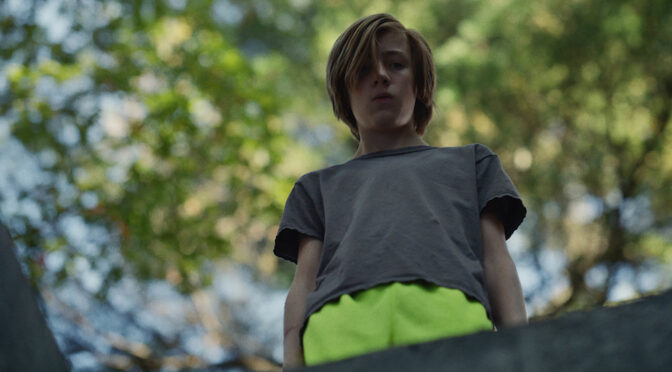 Pascual Sisto displays considerable skill for setting tone and atmosphere in discordant and unsettling thriller JOHN AND THE HOLE. However, strange structural and storytelling choices prevent his debut feature from being the cryptic curio it wants to be.
Pascual Sisto displays considerable skill for setting tone and atmosphere in discordant and unsettling thriller JOHN AND THE HOLE. However, strange structural and storytelling choices prevent his debut feature from being the cryptic curio it wants to be.
John (Charlie Shotwell) is a strange and inquisitive child who lives in a palatial home with his wealthy family. An incomplete bunker nearby fascinates John, who asks his mother (Jennifer Ehle) and father (Michael C. Hall) why the previous owners built it. After drugging them and his sister (Taissa Farmiga), he moves them into the deep, sheer-sided hole and holds them there while attempting to go about adult life by himself in the house. In between scenes, a young girl, Lily (Samantha LeBretton), is relayed the story of ‘John and The Hole’ by her mother.
Sisto’s framing and blocking set an eerie tone and off-kilter atmosphere from the beginning of the film, a pattern that will be executed throughout, albeit with diminishing returns. As John strolls through the forest, the narrow depth of field keeps what he moves towards just out of defined sight, building unease and intrigue. A shot of the family dinner is placed outside the house, no audio from the interior, only nature noises from around the house: a voyeuristic and unsettling choice.
“Even if JOHN AND THE HOLE fails to cohere around an idea, the wider sound department’s work is where many of its successes reside.”
Sound is also a notable element generally, with responsibility for setting the tormented atmosphere falling to Nicolas Becker’s sound design. John’s drone falling from the sky (accompanied by the tumbling point-of-view shot from it) comes complete with a deeply unsettling swirl of whirrings and whines. John’s tennis practice is an inharmonious contrast of low frequency serving machine against the slightly dissonant whack of high-pitched racquet strings, denying a calm atmosphere even away from the house. Becker is a sound artist and editor who has impressive contributions in many films and worked on a recent sound-based standout, SOUND OF METAL. Even if JOHN AND THE HOLE fails to cohere around an idea, the sound and music departments’ wider work is where many of its successes reside.
However, despite evident tonal and technical skills, the film presents few – if any – ideas upon which to hang them. Further, when it may have been possible to leave some thematic gaps for audiences to project meaning into, the script’s structure prevents and confuses attempts to do that. In particular, the apparent framing device featuring Lily invites some interpretation. It isn’t apparent what that should be despite this device crowding the very gaps that would otherwise be available to fill with projected meaning.
“…when it may have been possible to leave some of these thematic gaps for audiences to project meaning into, the script’s structure prevents and confuses attempts to do that.”
John’s story could be viewed as a metaphor for adolescence, growing up more generally, or the things you need to compartmentalise to develop into an independent person. There are also ways it could be an allegory for the experience of developmental differences – John quite literally holds his family at a distance and shuns communicating with them, and is shown to be occasionally ill at ease socially. However, Lily and her mother’s segments imply some an overarching matter they are meant to elucidate or hint to, when – in reality – little can be inferred from what appears to be just a simple and unnecessary framing device.
There is plenty to commend the technical and performance aspects of JOHN AND THE HOLE. Still, the storytelling choices and structure fill in the intriguing gaps with narrative quicksand, into which the film’s potential slowly sinks.

